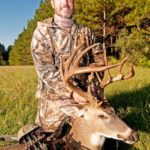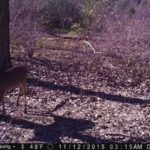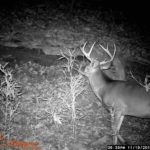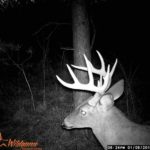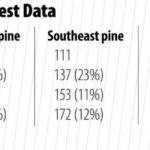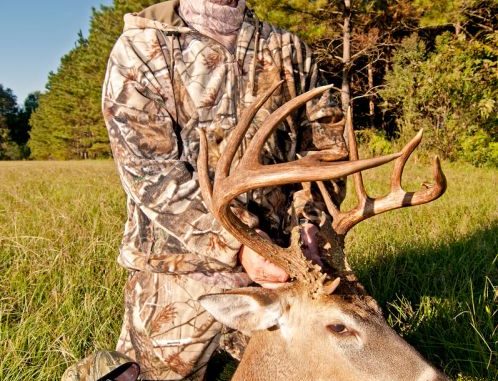
Are your antler expectations realistic? Find out.
Managing the buck harvest has become the norm for most deer programs these days.
Deer management has gone full circle since the state was restocked with deer in the 1950s and ’60s. After deer were re-stocked in the state and hunting began, hunting seasons were established to harvest antlered bucks only to allow further expansion of herds. As deer responded to this management scheme and habitat improved, deer numbers around the state increased and the concept of harvesting does using doe days began. As herds continued to grow and the buck harvest increased, doe hunting opportunities increased in an effort to maintain deer numbers in balance with the habitat. Eventually the DMAP program was initiated in the early 1980s and deer hunting became just that, a full season for hunting both bucks and does. Finally the state adapted full-season doe days. However, as habitat quality decreased and deer numbers began to decline in some areas the state has gone back to limited doe days in some areas. This season hunters will see a restriction in the number of deer that can be harvested in some areas, such as Area 4.
In the 1960s and ’70s, during the buck-only hunting days, hunting pressure began to increase and the age structure of the bucks being harvested began to decline. Older bucks, 3 ½ years and older were rare and the buck harvest was dominated with younger bucks. Younger bucks naturally do not have the large antlers that most hunters are looking for so hunters began to wonder what was going on. Many blamed the doe seasons that had been initiated during this time period. Too many does were being killed that produced bucks. The actual reason was simply the heavy hunting pressure on bucks. Hunters still had the mind set of buck only hunting and anything with antlers was fair game. Data from DMAP clubs in the mid eighties revealed that on many clubs, young bucks, 1 ½ years old, accounted for over 75% of the antlered buck harvest. Bucks simply were not living long enough to reach the age classes where antler growth is the best. Other states across the country were seeing similar trends. In order to harvest bucks with larger antlers, hunters needed to reduce their harvest of younger bucks and allow them to grow older. This is easier said than done.
Then along came the concept of managing for quality deer, let them go and let them grow. Today the Quality Deer Management Association and the concept of quality deer management has taken hold in Louisiana and many clubs and landowners across the state are involved with this organization and management concept one hundred percent. Now more adult bucks that are 3 ½ years or older are being harvested than bucks 1 ½ years old.
Realistic goals
Deer management plans need to have goals that are realistic, goals that can be achieved. Jimmy Ernst, the DMAP Coordinator for LDWF wrote in a recent article that hunters will often say they want big bucks and lots of them. This is not a realistic goal. Most hunters would probably describe a big buck as one that scores around 160 on the B&C scale. This is indeed a big buck and really is something that realistically cannot be managed for. B&C bucks are few and far in between; perhaps if you have deer in a pen, feed them all they need to eat and allow them to reach six years of age one might be able to grow B&C bucks on a regular basis. But this is not the real world of deer management in Louisiana.
B&C class deer are produced in the Bayou State primarily in the river parishes where there is year-round agriculture. But only a handful are produced in the state annually so to set a buck harvest goal of only shooting 160 class deer is probably a pipe dream. B&C class deer have been produced on other habitat sites around the state but again, this is something that is difficult to manage for. One could say that bucks like these are anomalies. A tract of land in Desoto Parish that I work on has produced one B&C class deer in seven years. The habitat is basically mixed pine/hardwood forest with fields, not what would normally be considered big buck habitat. This buck simply had a good genetic make-up and was able to produce a great rack, something that cannot be duplicated each year.
Most habitat sites around the state can produce quality deer. A quality deer is one that generally will score around 120 B&C. This is a far cry from a true trophy class buck but one that a hunter should be proud of harvesting. The parish records for state record deer will support this. Prior to establishing the goals for a deer program the manager must have a clear understanding of the habitat that his deer herd lives on. The landowner in Tensas Parish with bottomland hardwood forest and agriculture will be able to produce larger deer than the landowner in Cameron Parish with marsh habitat or the landowner in St. Helena Parish with dominate pine plantation habitat. Having a good understanding of the deer habitat and the growth and development of the deer on this habitat is essential for the development of the buck management program and setting attainable goals.
Buck growth and development
The collection of harvest data is essential for understanding growth trends that occur in the deer herd. This is particularly true for the buck segment of the herd. This data would include live weight of harvested bucks along with antler measurements including beam length, circumference of base, number of points and inside spread. Documenting the B&C score for each buck, especially the 3 ½ and older bucks will clearly reflect antler growth trends as bucks move up into each age class from year to year. Baseline data is important to have to begin the process and if data is not available the first thing to do is simply harvest deer during the season from each age class and obtain a good data set for establishing goals.
The ideal trend for buck growth is something like this; six month old male fawns should average around sixty pounds; 1 ½-year-old males should double that weight in one year and weigh 120 pounds (or more); after this the ideal growth rate should be an annual increase of 25-40 percent of body weight up to age 4 ½ and then it should start slowing down. In pen situations the weight increase continues into the older age classes, but in the real world environment of our forests in Louisiana this is not the case.
Examination of DMAP harvest data from the 2015 Deer Season provided by Jimmy Ernst is included in the chart attached.
The DMAP data clearly shows that the herds in this state on all habitat sites are not achieving the body growth that would be needed to produce the quality deer hunters are looking for. This data would be sufficient to examine the deer herd that you are trying to manage. The data shows that the average live weight of young 1 ½ year olds is low. Now some of these low yearling weights could be that hunters are selecting bucks that are below average, something that is a good thing to be doing, consequently the data is not a true reflection of what is really out there. That is why I say to just shoot some bucks in all age classes and get a good picture of what is out there on the landscape.
The data shows that the best growth occurs from age one to age two. The percentage increase is great for the northwest pine and bottomland hardwood habitat but is somewhat low for the southeast pine woods. This is probably a true reflection of what is going on in southeast Louisiana. Dramatic changes in the landscape in this part of the state has taken its toll on the deer habitat. Intense pine management has removed the quality browse that bucks need for good growth and development.
Percent of body increase for the older age classes is poor in all habitat types and again, reflects the changes that have occurred in the deer habitat. It could also reflect the need to harvest more deer on some of these sites. This is particularly true for the bottomland sites where habitat conditions should be good because of the available agriculture.
B&C scores for deer entered in the 2016 Big Buck Contest at the Louisiana Sportsman Show averaged around 124. This is a decent score and one that the manager could use as a measure of success for the buck harvest program. At this contest 62% of the bucks entered scored less than 130. Of the 38% that scored above 130 B&C, 19 bucks, only two scored 160+ and clearly shows that a score of 160 B&C is not a realistic goal.
Hopefully this has given you an idea of how to determine if your buck harvest program is working. You should set realistic goals that are in line with the habitat, and what the habitat will grow. The key, of course, is the habitat and the way to improve success is to maintain good habitat conditions that promote desirable growth and antler development.
